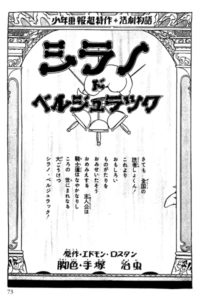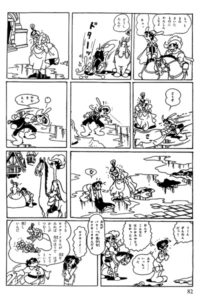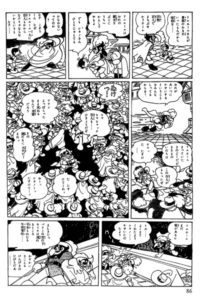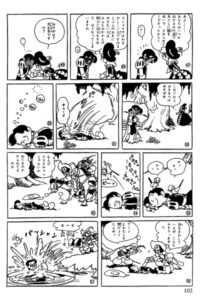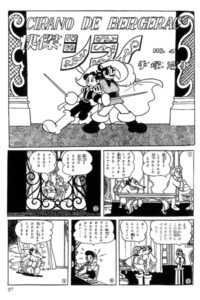Cyrano the Hero (Manga)
Also known as 快傑シラノ (Kaiketsu Shirano)
| English Title: | Cyrano the Hero |
| In English? | No |
| Japanese Title: | 快傑シラノ [Kaiketsu Shirano] |
| Type: | Ongoing Serial |
| Original run: | 1953/04 – 1953/09 |
| Published in: | Shonen Illustrated [少年画報] |
| Published by: | Shonen Gahosha |
| Volumes: | >1 |
Osamu Tezuka’s take on the French literary work, Cyrano the Hero (1953) was originally published over 7 monthly instalments, from April to November 1953, in Shonen Illustrated [少年画報] – sandwiched in between the first and second runs of Tezuka’s cowboy adventure, The Cactus Kid (1951-54).
What it’s about
Cyrano de Bergerac, a nobleman serving as a cadet in the French Army is a man of many talents, with a large personality and an even larger nose. An amazing swordsman, he is equally gifted in the areas of poetry and music. However, his brash attitude soon puts him at odds with Chancellor Richelieu and the Compte de Guiche – a couple of ne’er-do-well noblemen who are plotting to overthrow the king.
Meanwhile, Christian, a swordsman from the country, is in Paris. As his friend, Ligniere, is showing him around the city, the pair cross paths with the lovely Roxanne. Although the chivalrous Christian drapes his cloak (along with every other stitch of clothing) over a series of puddles to let Roxanne pass unsullied, he is much too shy to approach her directly.
After Christian refuses to become involved in the treasonous plots that Richelieu and the Compte de Guiche are hatching, his life is endangered. However, the lovely Roxanne implores her friend Cyrano to protect Christian. Since Cyrano secretly loves Roxanne but is too ashamed of his large nose to tell, he is unable to resist her charms and begrudgingly agrees to help.
Of course, soon Christian is looking to Cyrano for more than just his skill with a sword. When Roxanne invites Christian to a party at her home and asks him to recite his poetry, he is in a bind. Since Christian is hopeless at memorizing lines, Cyrano ends up stationed outside Roxanne’s window. Although she is moved by Cyrano‘s words – albeit coming from Christian‘s mouth – the Compte de Guiche and his men suddenly arrive in an attempt to convince her to marry him. Knowing they mustn’t find Christian there, Cyrano begins to fight the men on the rooftop…
…and with that Cactus Sam suddenly announces he is trading in his épée for a six-shooter and changes back into his cowboy garb.
What you should know
As most fans know, Osamu Tezuka was a big fan of classical literature. However, while works like Crime and Punishment (1953) and Son-Goku the Monkey (1952-59) stand out as well-known and successful examples of this, just how deeply Tezuka drew on the classics is perhaps less well understood. For example, Tezuka’s even more well-known fascination with Disney animation often overshadows the fact that his manga adaption of Pinocchio (1952) is actually a refreshing blend that draws equally from both the feature film and the original source material.
And while none of them can really top Tezuka’s love for Goethe’s play – having been adapted no less than three times into Faust (1950), One Hundred Tales (1971), and Neo-Faust (1989) – his affection for Rostand’s play is the only other one that comes close.
According to Tezuka, “I loved the old-fashioned grandeur of Cyrano so much that I used to recite the lines from memory. I prefer bold, adventurous dramas over those that pursue realism. This medieval story – with its show-off, worldly, and human feel – was the perfect aid for escaping the disquieting emotions of those days” (Nobi Nobi, Asahi Shimbun, 1975).
Of course, Tezuka’s fixation on rather large proboscises might have also had something to do with it. Regardless, he adapted the classic Cyrano de Bergerac into manga on three occasions. The last was in the Rainbow Parakeet (1981-82) chapter “Cyrano de Bergerac” (1981). The second was in the Black Jack (1973-83) chapter “Timid Cyrano” (1977), but the first… and probably the best, was in Cyrano the Hero (1953).
Featuring Duke Red in one of his few starring roles, Cyrano the Hero (1953), like all of Tezuka’s other adaptations, is a manga adventure first. As such, while the main storyline and themes are recognizable, they are not wholly intended to be a “Classics Illustrated” treatment of the source material.
Unfortunately, Cyrano the Hero (1953) didn’t catch on with fans at the time. Despite Tezuka’s efforts to “shift gears” following the ending of The Cactus Kid (1951-54) in Shonen Illustrated, it appears most fans preferred cowboy to swashbuckling adventure. Always carefully attuned to the desires of his fanbase, Tezuka abandoned Cyrano the Hero (1953) after a mere 7 chapters and quickly reverted back to the more popular The Cactus Kid (1951-54) feature.
What else you should check out
Check out the link below for chapter summaries and more detailed original publication information on the Cyrano the Hero (1953) serialization in Shonen Illustrated.

